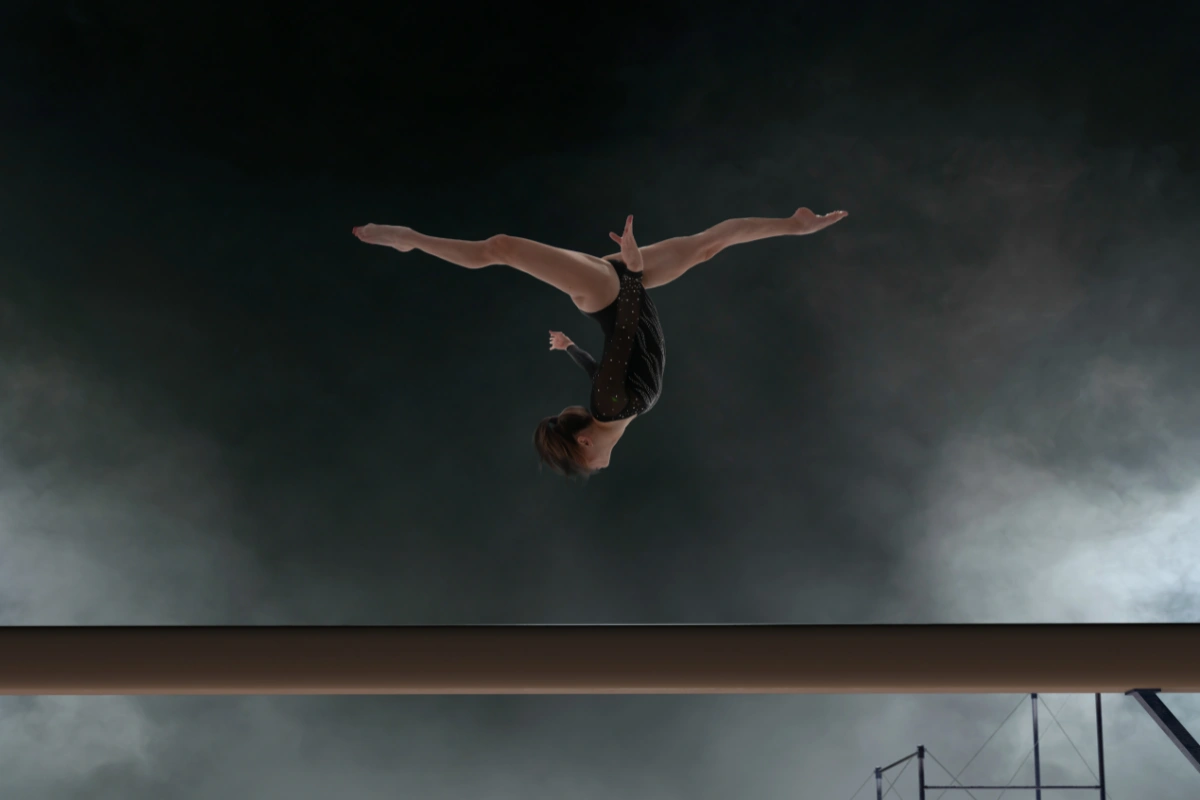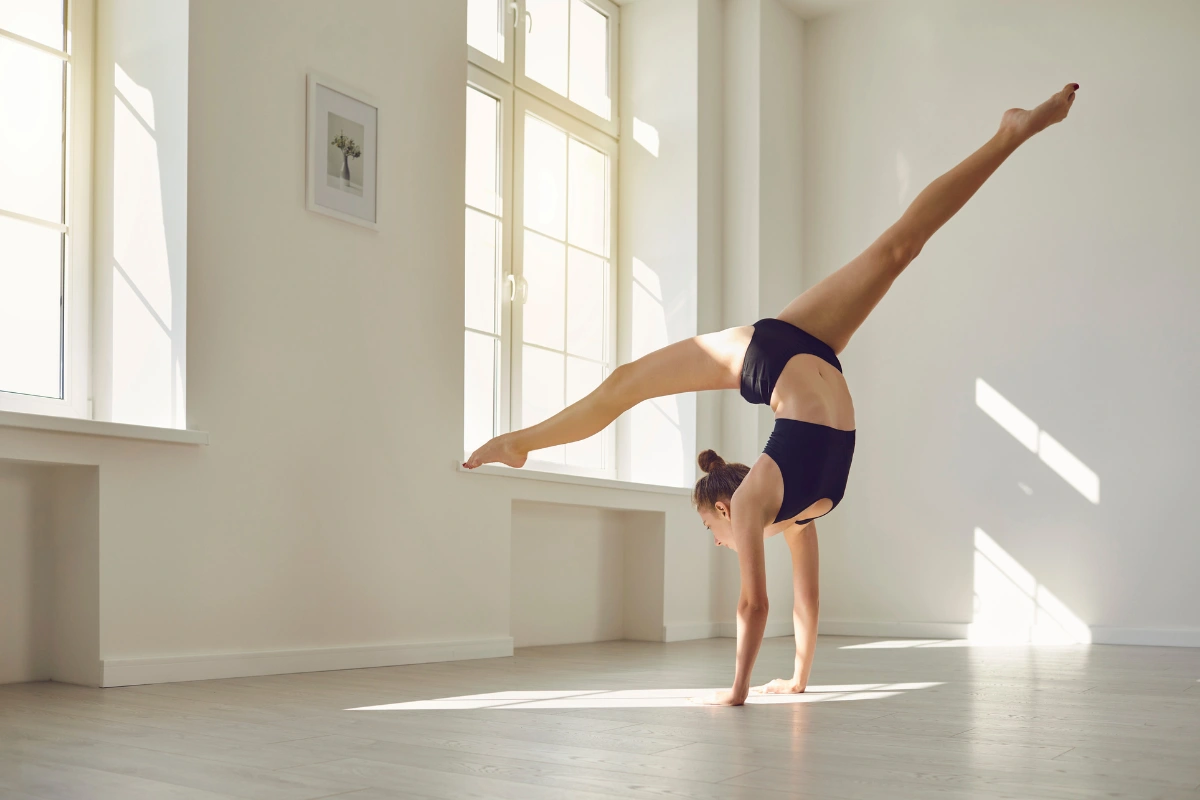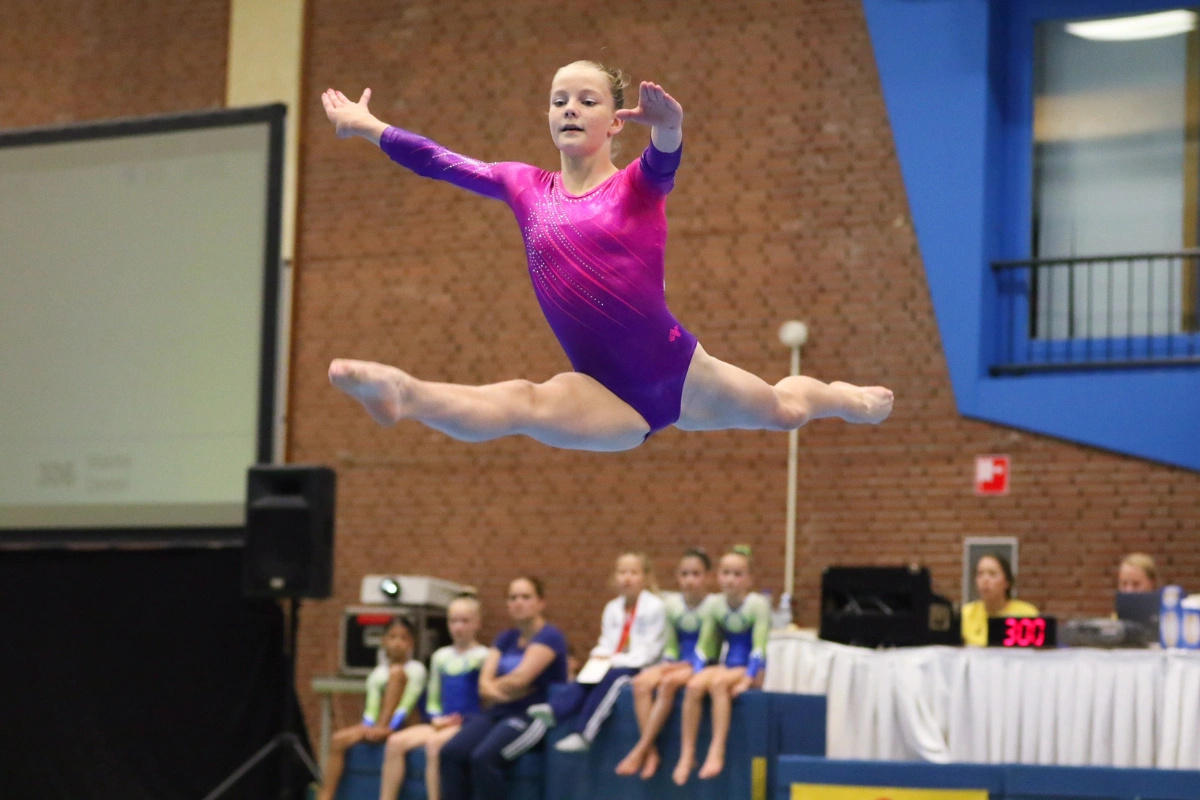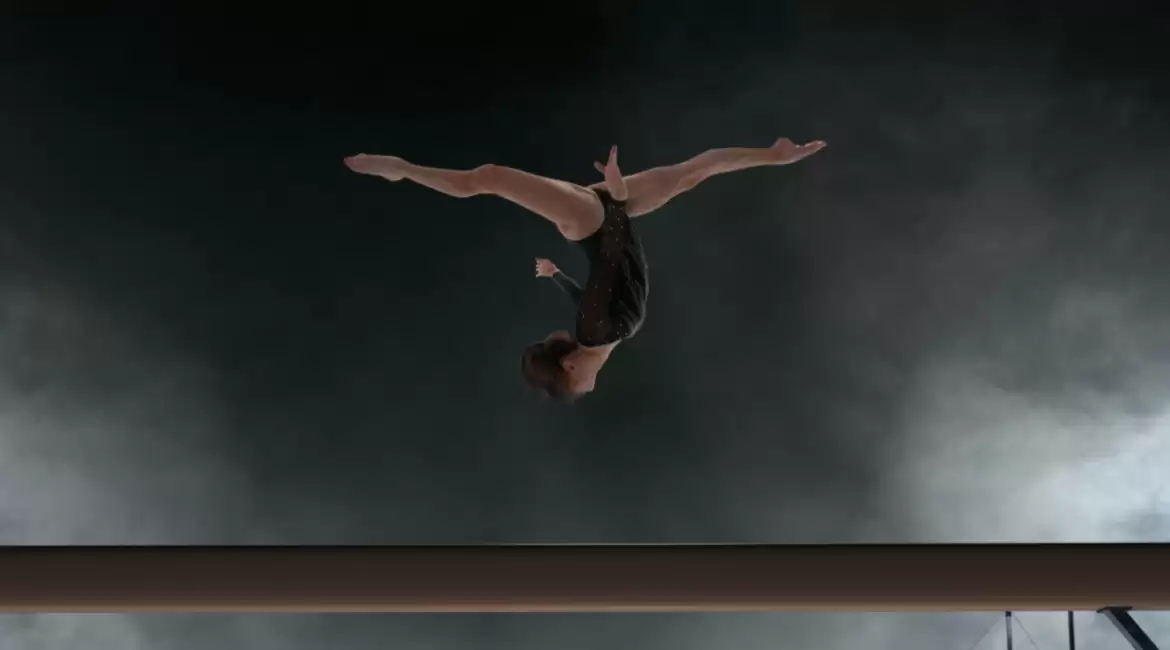Welcome to our journey through the world of gymnastics! This dynamic sport combines athleticism with creativity, offering a host of benefits for participants of all ages. In this exploration, we’ll define gymnastics, explore its fascinating history, and uncover the many ways it positively impacts our lives. Let’s dive in and discover the wonders of gymnastics together!
What is gymnastics?
Gymnastics, defined as a sport, encompasses a multifaceted array of movements demanding not only physical prowess but also a blend of attributes including strength, flexibility, balance, endurance, gracefulness, and kinesthetic awareness. These movements span a spectrum from handsprings, handstands, split leaps, aerials, to cartwheels, each requiring precision and mastery. Originating from ancient Greek beauty practices and fitness routines, gymnastics has its roots in various activities such as horse mounting and dismounting techniques, as well as skills associated with circus performances. Its introduction to the United States circa 1830 marked the beginning of a transformative journey, propelling it into the realm of a perennial Olympic sport.

History
The history of gymnastics stretches back millennia, tracing its origins to the ancient Greeks, who held physical fitness in high regard. The term “gymnastics” derives from the Greek word “gymnos,” meaning naked, reflecting the Greeks’ preference for exercising unclothed. Across Greek cities, dedicated spaces known as gymnasia provided venues for activities like jumping, running, and wrestling. As the Roman Empire rose to prominence, Greek gymnastics transitioned into military training, with innovations like the wooden horse introduced by the Romans. However, with the decline of the Roman Empire and the abolition of the Olympic Games in 393 C.E., gymnastics, along with other sports, fell into obscurity.
It wasn’t until the late eighteenth and early nineteenth centuries that gymnastics saw a revival, thanks to pioneering physical educators like Johann Friedrich GutsMuth and Friedrich Ludwig Jahn. Their development of exercises and apparatus for boys and young men laid the groundwork for modern gymnastics. Jahn, often hailed as the father of modern gymnastics, created early versions of essential equipment such as the horizontal bar, parallel bars, and vaulting horse.
By the end of the nineteenth century, men’s gymnastics gained popularity, earning a place in the inaugural modern Olympic Games in 1896. However, competitions during this period featured a variety of exercises, including synchronized team floor calisthenics and rope climbing, which may seem unfamiliar to contemporary audiences. Women’s involvement in gymnastics began in the 1920s, with synchronized calisthenics making its debut at the 1928 Amsterdam Games.
The standardization of apparatus and events for both genders occurred during the 1954 Olympics, alongside the establishment of uniform grading systems. Soviet gymnasts emerged as dominant forces during this era, showcasing highly disciplined and challenging performances that captivated audiences worldwide. The advent of television further popularized gymnastics, propelling it into a modern age of international interest.
Nadia Comaneci made history at the 1976 Montreal Olympics by achieving the first perfect score, under the guidance of her renowned coach Bela Karolyi. Despite her remarkable achievement, the Romanian team fell short of securing the gold medal. Comaneci’s flawless performances left an indelible mark, demonstrating that perfection could indeed be attained.
In 2006, a new scoring system was introduced, replacing the traditional 1 to 10 scale with start values based on the difficulty of routines. Additionally, higher deductions were implemented, aimed at reducing the likelihood of perfect scores. This change aimed to add complexity and fairness to gymnastics competitions, reflecting the sport’s ongoing evolution.

What equipment is needed for gymnastics?
When it comes to teaching gymnastics, a variety of equipment can greatly enhance the learning experience and ensure safety. Among the essential items are:
- Balance Beam: A narrow, elevated beam that provides a platform for practicing balance skills such as leaps, turns, and acrobatic movements. It helps gymnasts develop precision, coordination, and confidence in their movements.
- Pommel Horse: This apparatus consists of a padded, cylindrical body with two handles, designed for mastering skills like circles, travels, and dismounts. It is crucial for developing upper body strength, core stability, and agility.
- Trampoline: An elastic surface that enables gymnasts to perform aerial maneuvers, flips, and twists with greater ease and safety. Trampolines enhance spatial awareness, timing, and air sense, essential for mastering advanced tumbling skills.
- Cushioned Mats: Thick, shock-absorbing mats provide a safe landing surface for practicing various gymnastics skills, including jumps, flips, and vaults. They minimize the risk of injuries and instill confidence in gymnasts as they progress in their training.
- PE Benches: These versatile benches serve multiple purposes in gymnastics training, including stretching, conditioning, and as elevated platforms for practicing skills like handstands and cartwheels. They offer stability and support for various exercises and can be adjusted to accommodate different skill levels.

What are some skills taught in gymnastics?
In gymnastics, a wide array of skills is taught to children as they embark on their journey in this dynamic sport. These skills not only help develop physical strength, flexibility, and coordination but also instill discipline and perseverance. Here are some of the fundamental gymnastic movements and skills children become acquainted with during their gymnastics lessons:
- Body Tension: Learning to engage muscles to maintain straight limbs and create intricate shapes forms the foundation of gymnastic movements. Children are encouraged to cultivate strong body tension through exercises targeting core muscle development.
- Bridge: Progressing from a crab walk, the bridge is a challenging move that requires support and proper technique to execute safely. Children are guided in mastering this foundational gymnastic skill under supervision.
- Chassis Step: This dynamic movement involves hopping forward or sideways onto the balls of one foot before bringing the other foot to meet it, performed with fluidity and speed.
- Egg Roll: Curling up into a tight ball with the chin tucked in and rolling sideways with tension in the body helps children develop spatial awareness and control.
- Forward Roll: Teaching the importance of momentum and control, the forward roll requires quick execution and precise hand placement to ensure a straight exit.
- Half Turn Jump: Executing a 180-degree turn in mid-air and landing facing the opposite direction enhances coordination and agility.
- Jumping Jack: A dynamic movement involving a star-shaped jump with arms and legs extended sideways before landing with knees bent and arms raised.
- Landing: Children learn the proper technique for concluding gymnastic skills or movements safely and effectively.
- Log Roll: Rolling from back to front with legs together and arms stretched overhead helps develop coordination and body control.
- Pivot: Rotating on the ball of one foot enhances balance and spatial awareness.
- Sequence: Combining multiple skills in succession helps children develop fluidity and rhythm in their movements.
- Straddle: Practicing a wide-legged stance facing forward improves flexibility and range of motion.
- Straight Jump: Executing a vertical jump with proper form and control strengthens lower body muscles and coordination.
- Travel: Basic movement actions such as skipping, running, or hopping enhance agility and coordination.
- Tuck Jump: Jumping with knees bent and brought towards the chest while maintaining a straight body position challenges coordination and core strength.

How does gymnastics benefit us?
Gymnastics offers a multitude of benefits that extend beyond physical fitness, impacting various aspects of our well-being. Here are some ways gymnastics benefits us:
- Physical Fitness: Gymnastics promotes overall physical health by enhancing strength, flexibility, coordination, and balance. Through a combination of dynamic movements and static holds, gymnasts develop strong muscles and bones, improving cardiovascular health and reducing the risk of obesity and related health issues.
- Motor Skills Development: Gymnastics helps refine fine and gross motor skills, as participants learn to control their bodies in precise and coordinated movements. This includes skills such as hand-eye coordination, spatial awareness, and proprioception, which are essential for everyday activities and sports performance.
- Flexibility and Range of Motion: Regular practice of gymnastics stretches and lengthens muscles, increasing flexibility and range of motion. Improved flexibility not only enhances athletic performance but also reduces the risk of injury and promotes better posture and joint health.
- Discipline and Focus: Gymnastics requires discipline and concentration to master complex skills and routines. Through structured training sessions and goal-oriented practice, participants develop mental discipline, focus, and perseverance, which can translate to success in other areas of life, such as academics and personal goals.
- Self-Confidence and Self-Esteem: Achieving new skills and overcoming challenges in gymnastics boosts self-confidence and self-esteem. As gymnasts progress and achieve milestones, they develop a sense of accomplishment and pride in their abilities, fostering a positive self-image and resilience in the face of setbacks.
- Social Skills and Teamwork: Gymnastics provides opportunities for social interaction and teamwork, whether through group classes, team competitions, or collaborative training sessions. Working with coaches and peers teaches important social skills such as communication, cooperation, and sportsmanship, fostering friendships and a sense of camaraderie within the gymnastics community.
- Stress Relief and Mental Health: Engaging in physical activity like gymnastics releases endorphins, neurotransmitters that promote feelings of happiness and well-being, reducing stress and anxiety. Regular exercise also improves mood, boosts energy levels, and enhances cognitive function, contributing to overall mental health and resilience.
- Goal Setting and Achievement: Gymnastics encourages goal setting and goal achievement, as participants work towards mastering new skills, improving technique, and achieving personal bests. Setting and reaching goals in gymnastics instills a sense of ambition, motivation, and determination, fostering a growth mindset and a lifelong pursuit of excellence.
Summary
Gymnastics, a sport blending athleticism and artistry, boasts a rich history dating back to ancient civilizations like Greece. It involves a variety of movements and skills, from balance beams to tumbling routines, challenging both physical strength and mental focus. Beyond its competitive aspect, gymnastics offers numerous benefits, including improved flexibility, strength, coordination, and discipline. Additionally, participation in gymnastics promotes mental well-being, fostering confidence, resilience, and a sense of achievement. Whether practiced recreationally or competitively, gymnastics provides individuals of all ages and abilities with a platform for personal growth and development.


Leave a reply